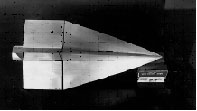![]() High Energy Launch Systems and Projectiles
High Energy Launch Systems and Projectiles
PI: Prof. Mark J. Lewis
Energetic materials and high-energy launch technologies offer the possibility of boosting payloads at very high accelerations, either above the atmosphere or at long ranges on earth’s surface. In particular, energetic materials derived from nano-particle formulations can yield rocket fuels with extremely high energy release rates, resulting in very high initial thrust profiles. Similarly, electromagnetic launch systems currently under development with both the U.S. Navy and U.S. Army hold the promise of gun systems that can launch massive projectiles with high initial velocities.
Traditional space launch systems tend to have moderate initial thrust levels, with relatively modest thrust-to-weight ratio. This means that conventional rockets begin their flight with thrust that is only marginally greater than weight, and thus initial accelerations are modest. This leads to an overall inefficient launch system. These resulting losses can be explained as follows. The Space Shuttle leaves its launch pad with a thrust-to-weight ratio of 1.54, gradually accelerating as fuel is consumed and weight is reduced. If the Shuttle had a thrust-to-weight ratio of exactly one, it would be hovering, and its fuel would be wasted. Thus, the smaller the thrust-to-weight, the more energy is expended just in fighting gravity during a vertical launch. In the case of the Space Shuttle, its final orbital velocity is 7,790 m/s in orbit, but its total required velocity increase during launch is 9,350 m/s, of which roughly 1,220 m/s is expended just in fighting gravity. Reducing these losses with higher initial accelerations could therefore have great benefit.
On earth, high-acceleration launch systems could be used for projectiles with extreme range. Traditional projectile systems are limited to at best a few tens of kilometers; and though concepts have been proposed for staged guns that can shoot projectiles hundreds of kilometers, longer-range flight has generally required the use of rocket systems. Developments in electromagnetic launch methods now make practical the delivery of tens of kilograms of projectile up to 150 kilometers or more. This would have significant military applications.
In both the space launch and gun cases described above, a key element is the efficient aerodynamic design for an object that will be accelerating to very high speed in a relatively dense portion of the atmosphere. The aerodynamic forces on an object are proportional to the local air density and the square of the velocity; power required to fight that drag scales with the cube of the velocity. Thus, there is considerably more drag on an object that begins low in the atmosphere at high velocity, as compared to one that with smaller acceleration. In the case of the Space Shuttle cited above, there is actually very little energy lost to aerodynamic drag – less than 10% of the gravitational losses. If the initial velocities were to increase, those aerodynamic losses would increase as well. The key is finding an aerodynamic shape that can minimize aerodynamic drag at the initial high acceleration forces.
There is a similar problem for high-speed energetic projectiles. Emerging from a gun barrel at extreme initial velocities will also include significant initial drag unless the object is carefully designed. With poor performance, a significant fraction of the initial energy can be lost, reducing the range and negating the benefits of the high-energy system.
This project has begun with an analysis of the trajectory options for a high-energy launch, examining the detailed velocity and altitude profiles for an optimal flight profile. A parametric examination of aerodynamic performance, including requirements for both lift and drag, has been included. The goal is to first determine if performance goals are achievable – for instance, can a projectile reach a desired 150 km with realistic, achievable aerodynamic coefficients? Can a launch system deliver a payload to orbital altitude and velocity with an extremely high initial acceleration? With those parameters identified, the next step will be to identify a class of optimized configurations that minimize energy loss, and that extend range as desired.
In some cases, the derived geometries may be highly non-traditional. Projectiles with high aspect ratio, or efficient shockwave utilization, might be a likely outcome. Using aerodynamic optimization techniques, coupled to the optimal trajectory approaches, these configurations will be explored with an eye towards their practicality and performance across a wide flight envelope.

Optimized “Star-body” projectile for reduced initial drag

